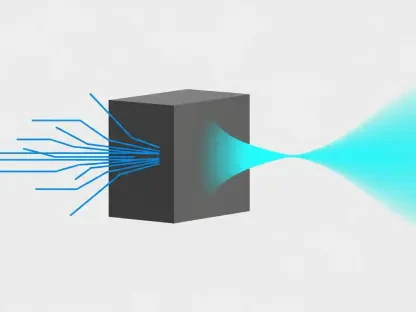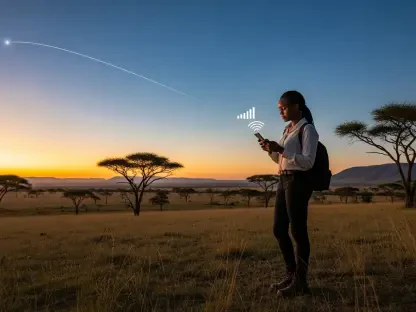The rapid evolution of military operations in an era of digital warfare has placed unprecedented demands on communication systems, with the need for instantaneous, secure, and reliable connectivity becoming a cornerstone of national security. Enter 5G technology, a game-changer poised to revolutionize defense communications by enabling real-time coordination across vast and complex battlefields. This transformative leap offers ultra-fast data speeds and massive device connectivity, addressing critical gaps in traditional military networks. This review delves into how 5G is shaping the defense sector, exploring its technical prowess, real-world impact, and the challenges that lie ahead in its adoption.
Introduction to 5G in Defense Communications
The emergence of 5G technology represents a significant shift in telecommunications, characterized by ultra-low latency, expansive bandwidth, and the ability to connect millions of devices simultaneously. These attributes make it uniquely suited to meet the rigorous demands of military environments where split-second decisions can determine outcomes. Unlike its predecessors, 3G and 4G, which struggled with speed and capacity under high-stress scenarios, 5G delivers robust performance tailored for dynamic defense operations.
In the context of rising geopolitical tensions, the urgency for secure and instantaneous communication networks has never been greater. Defense sectors worldwide are prioritizing modernization to counter sophisticated threats, and 5G stands at the forefront of this digital transformation. Its capacity to support encrypted, high-speed data transfer aligns with the strategic need for resilience in hostile regions.
The relevance of 5G extends beyond immediate tactical advantages, embedding itself into the broader framework of military innovation. As nations invest in digital warfare capabilities, this technology serves as a foundation for integrating advanced systems, ensuring that defense forces remain agile and prepared for evolving challenges.
Key Technical Features of 5G for Defense
Ultra-Low Latency and Real-Time Data Exchange
One of the standout features of 5G in defense applications is its ultra-low latency, which facilitates near-instantaneous communication across various military assets. This capability ensures that soldiers on the ground, unmanned vehicles in the air, and command centers miles away can exchange critical information without delay. Such responsiveness is vital in high-stakes environments where timing directly impacts mission success.
Performance metrics highlight the superiority of 5G, with latency reduced to mere milliseconds compared to older networks. In battlefield coordination, this translates to faster updates on enemy movements or logistical needs, allowing for rapid strategic adjustments. The technology’s ability to handle real-time data streams enhances situational awareness across multiple fronts.
This feature fundamentally boosts operational efficiency by minimizing communication lags that could otherwise jeopardize missions. Decision-making speed is amplified, enabling commanders to respond to threats with precision, thus redefining how military engagements are planned and executed in modern warfare.
Enhanced Security and Encryption Protocols
Security remains a paramount concern in defense communications, and 5G introduces advanced mechanisms to protect sensitive military data from cyber threats. Built-in encryption standards are designed to shield transmissions from interception, ensuring that strategic plans and troop movements remain confidential even in contested digital spaces.
Network slicing, a key innovation of 5G, allows for the creation of isolated, secure channels dedicated to specific defense operations. This segmentation means that even if one channel is compromised, others remain unaffected, preserving the integrity of broader communication networks. Such resilience is crucial in environments prone to electronic warfare.
The significance of these security features becomes evident in geopolitically sensitive regions where adversaries may deploy sophisticated hacking tools. By safeguarding data integrity and communication privacy, 5G equips military forces with a robust defense against digital espionage, reinforcing trust in critical operations.
Recent Advancements in 5G Defense Technology
Significant strides have been made in adapting 5G for defense purposes, with notable collaborations driving innovation in this space. A prominent example is the partnership between Nokia and Latvijas Mobilais Telefons (LMT), which focuses on developing 5G-based systems for military use in the Baltic region. This initiative underscores the technology’s potential to deliver secure, high-speed connectivity tailored for strategic needs.
Another trend shaping the landscape is the integration of 5G with cutting-edge technologies like artificial intelligence and the Internet of Things (IoT). These combinations enable smarter military networks capable of predictive analytics and autonomous decision-making, enhancing the scope of operations. Such advancements are paving the way for more adaptive and responsive defense frameworks.
Investment in secure communication infrastructure is also on the rise, with both governments and private sectors allocating substantial resources. This financial commitment reflects a growing recognition of 5G’s role in national security, pushing the boundaries of what military communication systems can achieve in terms of reliability and reach over the coming years.
Real-World Applications in Military Operations
The practical deployment of 5G in military settings showcases its transformative impact through specific use cases. Real-time data sharing among unmanned vehicles, field sensors, and personnel allows for seamless coordination during complex missions. This interconnectedness ensures that all elements of a military operation remain synchronized, enhancing overall effectiveness.
A compelling model of 5G’s application is seen in the Baltic region, where heightened military readiness necessitates advanced communication tools. The technology’s implementation here supports rapid information exchange in a strategically critical area, offering a blueprint for other regions facing similar security demands. Its success in such contexts highlights adaptability to diverse operational needs.
Beyond combat scenarios, 5G proves versatile in applications like disaster response coordination and border security monitoring. By enabling swift communication during crises or surveillance along national boundaries, the technology extends its utility to non-traditional defense roles, demonstrating a broader capacity to support public safety and humanitarian efforts.
Challenges and Limitations in Adoption
Despite its promise, the adoption of 5G in defense faces substantial technical hurdles, particularly the need for extensive infrastructure to support connectivity in remote or hostile environments. Establishing reliable networks in such areas requires significant investment in hardware and maintenance, posing logistical challenges for widespread implementation.
Regulatory obstacles also impede progress, with spectrum allocation issues often delaying the rollout of 5G for military use. Governments must navigate complex policies to ensure that frequency bands are available without interfering with civilian networks, a process that can slow down strategic deployments in critical zones.
Cybersecurity risks further complicate the landscape, as 5G networks, despite advanced protections, remain potential targets for state-sponsored attacks. Vulnerabilities in interconnected systems could expose sensitive data, prompting ongoing efforts to develop countermeasures. Addressing these concerns remains a priority to build confidence in the technology’s reliability for defense purposes.
Future Prospects of 5G in Defense
Looking ahead, the integration of 5G with next-generation innovations like quantum computing holds immense potential for defense communications. Such advancements could revolutionize encryption methods, offering unparalleled security for military data transmissions. This synergy promises to fortify networks against even the most advanced cyber threats.
The technology is also expected to redefine military strategies by enabling fully connected, autonomous battlefields. With 5G as the backbone, future operations could rely on seamless coordination between human and machine elements, creating highly efficient combat ecosystems. This shift may fundamentally alter how conflicts are approached and resolved.
Geopolitically, the impact of 5G could be profound, especially in regions like the Baltics where secure communications influence power dynamics. Enhanced connectivity might provide strategic advantages, reshaping alliances and deterrence capabilities. Over time, this could contribute to a rebalancing of regional security frameworks through technological superiority.
Conclusion and Key Takeaways
Reflecting on the journey of 5G in defense communications, it becomes clear that its role is pivotal in modernizing military networks through unmatched speed, robust security, and scalable connectivity. The technology stands out as a cornerstone for operational advancements, despite facing significant barriers in infrastructure and cybersecurity.
A critical takeaway is the transformative potential that 5G demonstrates across various military applications, from battlefield coordination to disaster response. Yet, the path forward demands focused efforts to address regulatory and technical challenges that hinder broader adoption.
Moving ahead, stakeholders need to prioritize collaborative innovation and investment in resilient infrastructure to unlock 5G’s full capabilities. Strengthening cybersecurity measures and fostering international partnerships for spectrum management emerge as essential steps to ensure that defense forces can leverage this technology effectively in an increasingly digital and contested global landscape.









